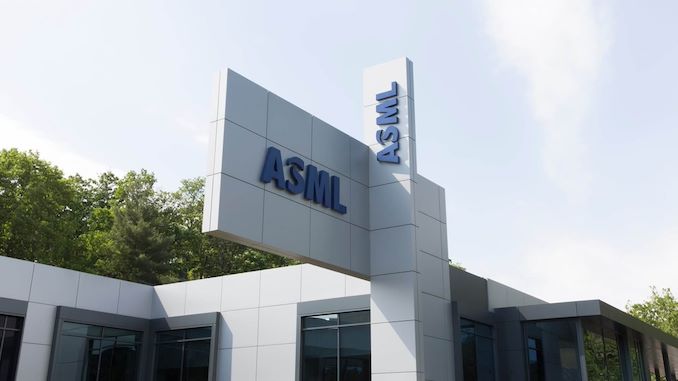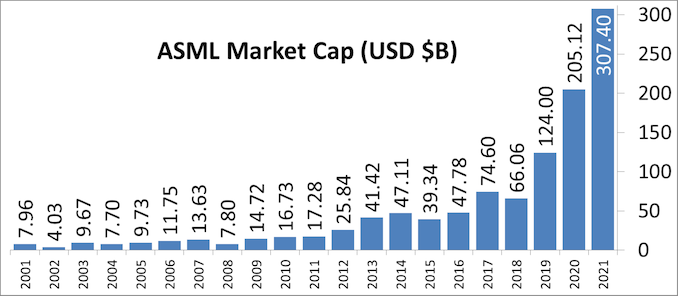Intel's Process Roadmap to 2025: with 4nm, 3nm, 20A and 18A?!
by Dr. Ian Cutress on July 26, 2021 5:00 PM ESTSidebar on Intel EUV
In all of these announcements, one thing to highlight is Intel mentioning its relationship with ASML, the sole company that manufactures the EUV machines powering production of leading edge semiconductor manufacturing.
ASML is a unique company in that it is the only one that can produce these machines, because the technology behind them is often tied up with its partners and research, but also because all the major silicon manufacturers are heavily invested in ASML. For any other company to compete against ASML would require building a separate network of expertise, a decade of innovation and design, and a lot of capital. None of the major silicon vendors want to disturb this balance and go off on their own, lest it shuts them out of the latest manufacturing technology, and no research fund sees competing against the embedded norm as a viable opportunity. This means that anyone wanting EUV specialist technology has to go to ASML.
In 2012, it was reported that Intel, Samsung, and TSMC all invested in ASML. This was, at the time, to jumpstart EUV development along with migrating from 300mm wafers to 450mm wafers. While we haven’t moved to 450mm wafers yet (and there are doubts we will any time in the next decade), EUV is now here. Intel’s 2012 investment of $2.1 billion gave them a 10% stake in ASML, with Intel stating that it would continue investing up to a 25% stack. Those stakes are now below the 5% reporting threshold, but all three of the major foundry customers are still big owners, especially as ASML’s market cap has risen from $24 Billion in 2012 to $268 Billion in 2021 (surpassing Intel).
As major investors but also ASML’s customers, the race has been on for these foundries to acquire enough EUV machines to meet demand. TSMC reported in August 2020 that it has 50% of all EUV machines manufactured at ASML for its leading edge processes. Intel is a little behind, especially as none of Intel’s products in the market yet use any EUV. EUV will only intercept Intel’s portfolio with its new Intel 4 process, where it will be used extensively, mostly on the BEOL. But Intel still has to order machines when they need them, especially as there are reports that ASML currently has backorders of 50 EUV machines. In 2021, ASML is expected to manufacture around 45-50 machines, and 50-60 in 2022. The exact number of machines Intel has right now, or has ordered from ASML, is unknown. It is expected that each one has a ~$150m price tag, and can take 4-6 months to install.
With all that being said, Intel’s discussion point today is that it will be the lead customer for ASML’s next generation EUV technology known as High-NA EUV. NA in this context relates to the ‘numerical aperture’ of the EUV machine, or to put simply, how wide you can make the EUV beam inside the machine before it hits the wafer. The wider the beam before you hit the wafer, the more intense it can be when it hits the wafer, which increases how accurately the lines are printed. Normally in lithography to get better printed lines, we move from single patterning to double patterning (or quad patterning) to get that effect, which decreases yield. The move to High-NA would mean that the ecosystem can stay on single patterning for longer, which some have quoted as allowing the industry to ‘stay aligned with Moore’s Law longer’.
| ASML's EUV Shipments | |||||||||||||||||||||
| 2015 | 2016 | 2017 | 2018 | 2019 | 2020 | 2021 | |||||||||||||||
| Actual | 2 | 4 | 10 | 3 | 4 | 5 | 6 | 4 | 7 | 7 | 8 | 4 | 7 | 14 | 8 | 7 | 9 | - | - | ||
| Target (Total) | - | - | - | 20 (18) | 30 (26) | 35 (33) | 45-50 | ||||||||||||||
| 2018 and beyond is split per quarter for actual shipped numbers Data taken from ASML's Financial Reports |
|||||||||||||||||||||
Current EUV systems are NA 0.33, while the new systems are NA 0.55. ASML’s latest update suggests that it expects customers to be using High-NA for production in 2025/2026, which means that Intel is likely going to be getting the first machine (ASML NXE:5000 we think) in mid-2024. Exactly how many High-NA machines ASML intends to produce in that time frame is unknown, as if they flood the market, having the first won’t be a big win. However if there is a slow High-NA ramp, it will be up to Intel to capitalize on its advantage.













326 Comments
View All Comments
mode_13h - Tuesday, July 27, 2021 - link
Anyway, the real point is that the first two of those iterations basically don't count. The first was *completely* noncompetitive and the second was *barely* competitive.Usually, when Intel introduces a new node, it's already superior to the existing node, which is something we can't really say until their 3rd gen 10 nm (SF). Granted, if they hadn't refined their 14 nm quite so much, Ice Lake (2nd gen 10 nm) probably would've compared more favorably to it.
AdrianBc - Tuesday, July 27, 2021 - link
I completely agree.TheinsanegamerN - Tuesday, July 27, 2021 - link
So they finally caught up to where they were before 5 years after the product was support to be used for a mass release? At least according to rumors, there's no telling if alder lake will actually be able to do that, let alone sustain such speeds.Skylake was supposed to be 10nm BTW.
Spunjji - Thursday, July 29, 2021 - link
"Skylake was supposed to be 10nm BTW."Based on what information? Are you sure you don't mean Kaby or Coffee Lake? Skylake was only the second architecture on 14nm - the tock to Broadwell's tick (or whichever way around that went).
Spunjji - Thursday, July 29, 2021 - link
TSMC hasn't always been like this. They had a history of delayed, underperforming, or even cancelled nodes - 32nm was a big one, as it screwed up both ATi and Nvidia's plans for a generation and effectively gave Nvidia time to catch up after the Fermi disaster. More recently, AMD had to cancel their 20nm projects because the node sucked, and swallow the resulting financial losses at a time when they couldn't really afford it.I'd say their secret sauce is learning from experiences like that and - as others have said - ploughing funds into R&D rather than resting on their successes.
throAU - Tuesday, July 27, 2021 - link
might be catching up in name but a shame they are still nowhere in terms of processing per watt.shabby - Tuesday, July 27, 2021 - link
Don't worry, pat will rename the watt to intel watt soon. Formula will be watt/2=intel watt = intel in more efficient than amd!29a - Tuesday, July 27, 2021 - link
I can't see that even making them more efficient, a 5600x literally uses 65w max.Oxford Guy - Wednesday, July 28, 2021 - link
Isn’t Apple’s M1 more efficient, as least in some workloads?mode_13h - Thursday, July 29, 2021 - link
Yes, efficiency is where the M1 really excels.